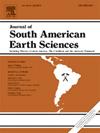Misconceptions about Lu-Hf isotopic system: A comment on Gómez-Torres et al. (2025) “U-Pb, Hf isotopes and trace elements of zircon reveals a Mesoproterozoic crustal source for the Jurassic Caopas sub-volcanic intrusion: Northern part of the Nazas Igneous Province in Mexico”
IF 1.7
4区 地球科学
Q3 GEOSCIENCES, MULTIDISCIPLINARY
引用次数: 0
Abstract
Gómez-Torres et al. (2025) [DOI: 10.1016/j.jsames.2024.105266] present geochemical data on major and trace elements in rocks and zircons, U-Pb zircon ages, and Lu-Hf zircon isotopic data from a limited sample set to investigate the petrogenesis of Middle Jurassic rhyolite in the subvolcanic Caopas intrusion. Their striking conclusion is that Mesoproterozoic crust (Oaxaquia-like rocks) served as the magma source for this intrusion through crustal reworking in a rift environment. However, I argue that there is no solid evidence to support this assumption. In this commentary, first, several formal issues, errors, and major omissions in the methodological procedures are pointed out, including a key point such as the handling of the zircon Hf model ages (TDM2[Hf]). Then, a correct treatment of the Lu-Hf data and a more plausible interpretation of the TDM2[Hf] are provided. This interpretation suggests that a mixing process was involved in the genesis of the Caopas intrusion between an undifferentiated basement (Oaxaquia-like, Permian, or Triassic crustal rocks) and juvenile material (fresh magma).

求助全文
约1分钟内获得全文
求助全文
来源期刊

Journal of South American Earth Sciences
地学-地球科学综合
CiteScore
3.70
自引率
22.20%
发文量
364
审稿时长
6-12 weeks
期刊介绍:
Papers must have a regional appeal and should present work of more than local significance. Research papers dealing with the regional geology of South American cratons and mobile belts, within the following research fields:
-Economic geology, metallogenesis and hydrocarbon genesis and reservoirs.
-Geophysics, geochemistry, volcanology, igneous and metamorphic petrology.
-Tectonics, neo- and seismotectonics and geodynamic modeling.
-Geomorphology, geological hazards, environmental geology, climate change in America and Antarctica, and soil research.
-Stratigraphy, sedimentology, structure and basin evolution.
-Paleontology, paleoecology, paleoclimatology and Quaternary geology.
New developments in already established regional projects and new initiatives dealing with the geology of the continent will be summarized and presented on a regular basis. Short notes, discussions, book reviews and conference and workshop reports will also be included when relevant.
 求助内容:
求助内容: 应助结果提醒方式:
应助结果提醒方式:


